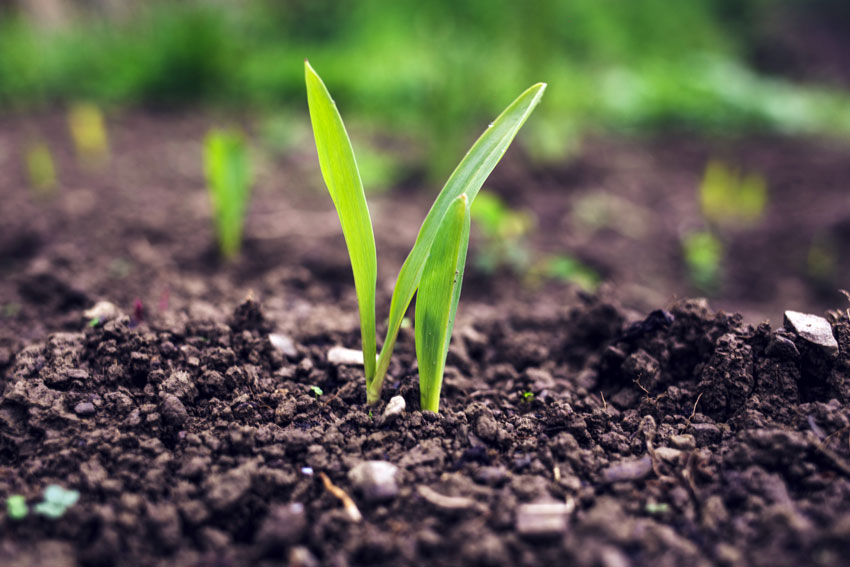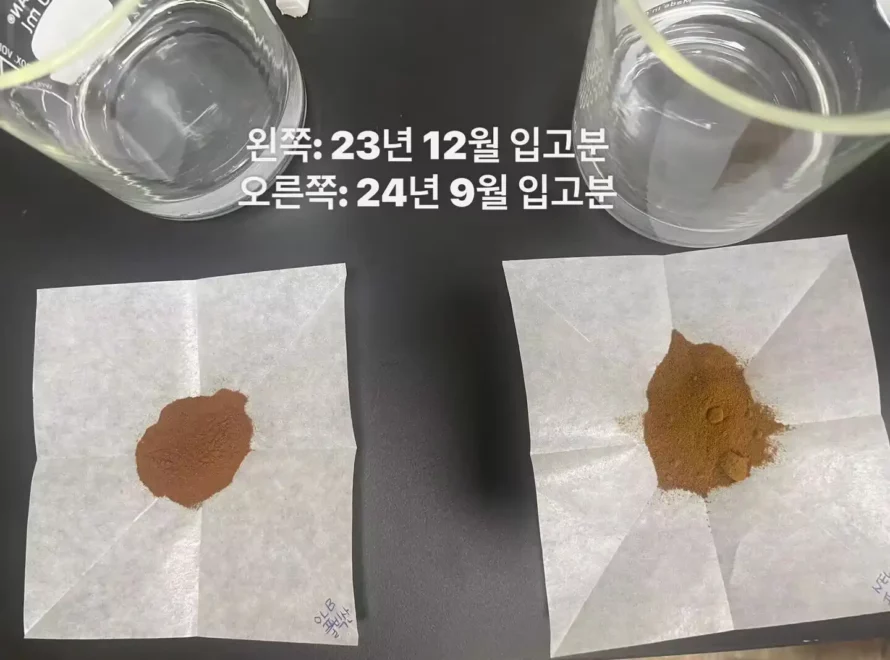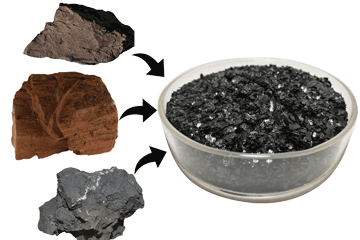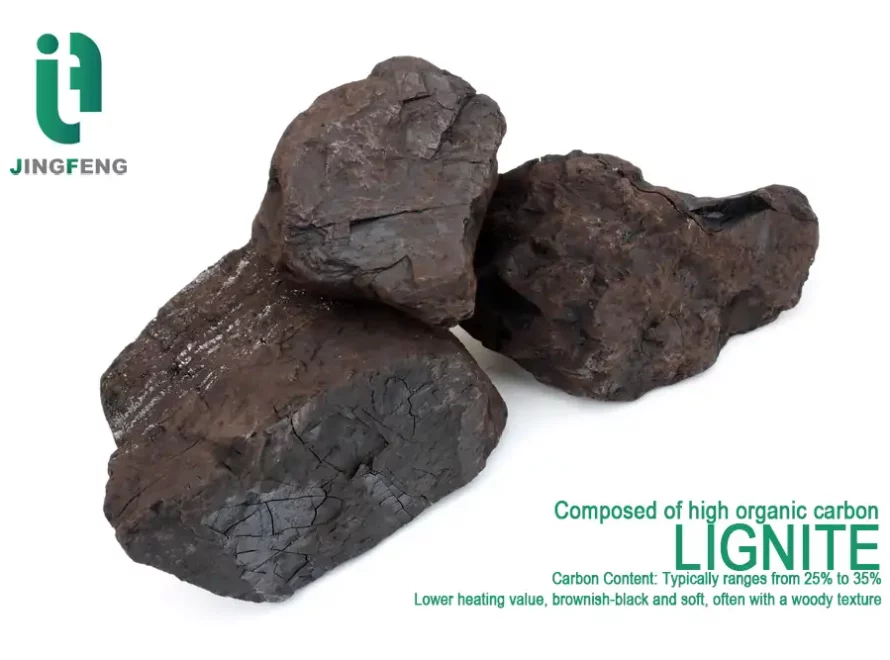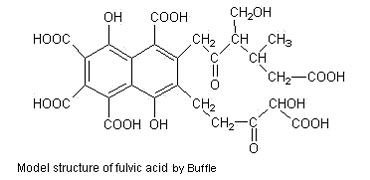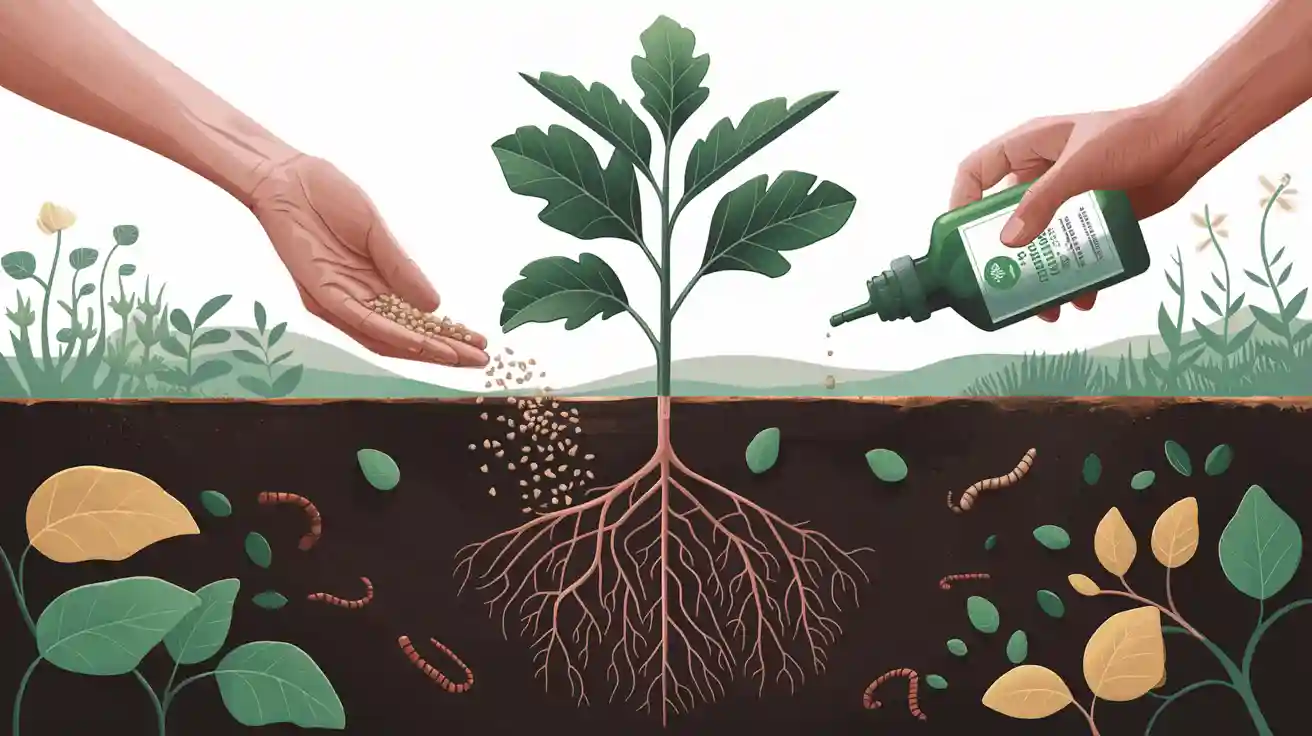
Achieving sustainable growth starts with selecting the right organic fertilizers for fruit and lawn crops and using biostimulants that match specific crop and soil needs. Farmers and gardeners worldwide see major benefits from this approach. For example, organic fertilizers improve soil structure, boost microbial life, and support long-term soil health. Global trends show a steady rise in organic farming, with over 77 million hectares now certified organic. Biostimulants also play a key role, helping plants absorb nutrients better and increasing resilience. Careful observation, regular soil testing, and adapting methods over time lead to healthier crops and stronger soil.
- Organic fertilizers come from natural sources like compost, manure, and seaweed, and they improve soil health by boosting microbes and water retention.
- Biostimulants help plants absorb nutrients better and increase their resistance to stress without supplying nutrients directly.
- Balanced nutrients, especially nitrogen, phosphorus, and potassium (N-P-K), are essential for healthy plant growth and high yields.
- Choosing the right organic fertilizer depends on the crop type, soil test results, and growth stage to meet specific nutrient needs.
- Applying fertilizers at the right time, place, and dose improves nutrient use and supports steady plant growth.
- Regular soil testing and observing plant health help farmers adjust fertilization for better crop performance and soil sustainability.
- Building living soil with compost, manure, and cover crops creates a strong foundation for long-term productivity and environmental safety.
- Using biostimulants in crops like cherries enhances flowering, fruit set, and stress tolerance, leading to higher and more consistent yields.
Organic Fertilizers and Biostimulants
Organic Fertilizers
Natural Sources
Organic fertilizer comes from natural materials that are rich in nutrients. Common sources include compost, manure, bone meal, fish emulsion, and plant-based materials such as seaweed extracts. Farmers and gardeners often use compost because it contains a wide range of nutrients and supports a diverse microbial community. Manure, when properly aged, supplies both nutrients and organic matter. Bone meal provides phosphorus and calcium, while fish emulsion offers a quick boost of nitrogen and micronutrients. Seaweed extracts supply trace minerals and natural growth hormones. These organic fertilizers release nutrients slowly, matching plant needs over time.
Benefits for Soil
Organic fertilizer improves soil in several important ways. Scientific studies show that organic fertilizers enhance soil structure by increasing microbial activity and diversity. Microbes secrete substances that bind soil particles, creating aggregates that improve aeration and water retention. This structure allows roots to grow deeper and access more nutrients. Organic fertilizer also increases soil organic matter, which acts as a carbon source for beneficial microbes. These microbes help break down organic materials, releasing nutrients in forms that plants can absorb. Over time, the use of organic fertilizers leads to higher soil fertility, better moisture retention, and reduced nutrient leaching. Economic data reveal that organic fertilizer treatments can boost net incomes by over 40% compared to conventional methods, mainly due to improved yields and soil health.
Compost and manure both improve soil, but compost offers unique advantages. Compost reaches high temperatures during decomposition, killing weed seeds and pathogens. It also supports a more diverse microbial community, retains more carbon, and improves soil structure and water retention. Compost-amended soils can hold up to 20 times their weight in water, which helps prevent compaction and supports healthy root growth.
Biostimulants
Types and Functions
Biostimulants include substances such as humic acid, fulvic acid, amino acids, and seaweed extracts. These products do not supply nutrients directly but modify plant processes to improve growth and nutrient uptake. For example, humic and fulvic acids enhance root development and stimulate beneficial soil microbes. Amino acids help plants cope with stress, while seaweed extracts influence hormone signaling and root architecture. Biostimulants improve nutrient availability by making nutrients more soluble and accessible to plant roots. They also support soil health by increasing microbial diversity and activity, which promotes nutrient cycling.
Crop-Specific Effects
Field research demonstrates that biostimulants can improve crop yield, quality, and resilience. For instance, phosphate-solubilizing bacteria help maize and tomato plants absorb more phosphorus, leading to higher yields. Protein hydrolysates and seaweed extracts increase stress tolerance in crops such as rice, wheat, and tomato. These biostimulants help plants withstand drought, heat, and salinity by regulating nutrient use and stress-response pathways. Marine extracts have been shown to improve root growth and germination in crops like Arabidopsis and chickpea. The promotion of biostimulant products tailored to specific crops and soil conditions allows farmers to optimize plant health and productivity.
HUMICO Potassium Humate Liquid stands out as a premium organic fertilizer and biostimulant. This product contains 14% humic acid, 3% fulvic acid, and 1.1% potassium. It improves soil structure, boosts microbial life, and enhances nutrient uptake. Its liquid form allows for easy application through fertigation or foliar spray, making it suitable for a wide range of crops and soil types. Farmers using HUMICO Potassium Humate Liquid often see healthier plants, stronger roots, and increased resistance to environmental stress.
| Organic Fertilizer Source | Key Nutrients Provided | Soil Benefit |
|---|---|---|
| Compost | N, P, K, micronutrients | Improves structure, water retention |
| Manure | N, P, K | Adds organic matter, boosts microbes |
| Bone Meal | Phosphorus, Calcium | Supports root and flower growth |
| Fish Emulsion | Nitrogen, micronutrients | Quick nutrient release |
| Seaweed Extracts | Trace minerals, hormones | Enhances stress tolerance, root growth |
Essential Plant Nutrients
Plants require a balanced supply of nutrients to achieve healthy growth, high yields, and resilience against stress. These nutrients fall into two main categories: macronutrients and micronutrients. The three primary macronutrients—nitrogen, phosphorus, and potassium—are often referred to as N-P-K. Each plays a unique and vital role in plant development.
N-P-K Roles
Nitrogen
Nitrogen stands as a life element for plants. It forms the backbone of proteins, nucleic acids, and enzymes. Plants use nitrogen to build chlorophyll, which is essential for photosynthesis. This process allows plants to convert sunlight into energy. Nitrogen also supports the production of vitamins and plant hormones. When plants lack nitrogen, their leaves turn pale green or yellow, and growth slows. Too much nitrogen can cause excessive leaf growth and weak stems.
Phosphorus
Phosphorus acts as an energy element. It supports metabolism and helps plants store and transfer energy. Phosphorus forms part of structural macromolecules and enhances photosynthesis. It also aids in carbohydrate synthesis and transport, nitrogen metabolism, and fat synthesis. Phosphorus helps plants adapt to stress, such as drought or cold. Deficiency symptoms include dark green or purplish leaves and poor root development.
Potassium
Potassium serves as a quality element. It improves metabolism and stress resistance. Potassium activates more than 60 enzymes and helps move sugars from leaves to storage organs. It also helps plants use water efficiently and resist drought, disease, and temperature extremes. Potassium can promote nitrogen absorption, which supports overall plant health. Deficiency signs include leaf edge browning and weak stems.
Balanced N-P-K fertilization increases yield and quality. Field experiments show that optimal N-P-K ratios improve soil nutrient content, leaf area, and photosynthesis. Over-fertilization, however, can harm soil health and reduce yields.
| Nutrient | Role in Plant Growth and Yield | Key Functions |
|---|---|---|
| Nitrogen (N) | Essential for growth | Protein synthesis, chlorophyll, enzymes, vitamins, plant hormones |
| Phosphorus(P) | Supports metabolism and energy | Structural macromolecules, photosynthesis, carbohydrate and fat synthesis |
| Potassium (K) | Improves metabolism and stress resistance | Enzyme activation, sugar transport, water use, disease and stress resistance |
Micronutrients
Micronutrients, though needed in smaller amounts, are just as important as N-P-K. These include elements like manganese, molybdenum, boron, iron, copper, nickel, and zinc. Each micronutrient supports specific plant functions, such as enzyme activity, hormone regulation, and disease resistance. Plants show clear signs when they lack these nutrients.
Deficiency Signs
Deficiency symptoms vary by nutrient and crop species. For example, wheat plants with manganese deficiency show interveinal chlorosis, where the tissue between leaf veins turns yellow. Boron deficiency in wheat can reduce seed set efficiency from 97% in efficient lines to only 11% in inefficient ones. Iron deficiency often causes pale or yellow leaves, while molybdenum deficiency leads to stunted growth. Excess micronutrients can also harm plants, causing symptoms like necrosis or abnormal growth.
Visual diagnosis, combined with soil and plant testing, helps growers identify and correct nutrient imbalances. Adequate micronutrient supply improves crop quality, yield, and shelf life.
Interpreting Fertilizer Labels and Matching Ratios
Fertilizer labels display N-P-K ratios, such as 10-10-10 or 5-3-8. These numbers represent the percentage of each nutrient in the product. Matching the right ratio to crop needs ensures optimal growth. For example, fruiting crops may need higher potassium, while leafy vegetables benefit from more nitrogen. Soil testing guides these choices by revealing existing nutrient levels. Farmers and gardeners should adjust fertilizer types and rates based on crop type, soil condition, and growth stage.
Choosing Organic Fertilizers for Fruit and Lawn Crops
Selecting the right organic fertilizers for fruit and lawn crops requires a careful look at nutrient ratios, ingredient sources, and crop-specific needs. Farmers and gardeners who understand how to fertilize based on soil conditions and plant requirements achieve better yields, healthier plants, and sustainable results.
Product Selection
N-P-K Ratios
N-P-K ratios describe the percentage of nitrogen, phosphorus, and potassium in an organic fertilizer. Each crop type absorbs these nutrients at different rates. For example, leafy vegetables like spinach need more nitrogen, while tomatoes and cherries benefit from higher phosphorus and potassium during flowering and fruiting. Lawns, especially Bermuda grass, thrive with balanced N-P-K ratios that support steady growth and color.
A well-chosen organic fertilizer for fruit and lawn crops matches the nutrient needs revealed by soil testing. Soil tests measure available nitrogen, phosphorus, and potassium, guiding how to fertilize for optimal plant health. Farmers use these results to select products with the right nutrient concentrations, avoiding both deficiencies and excesses.
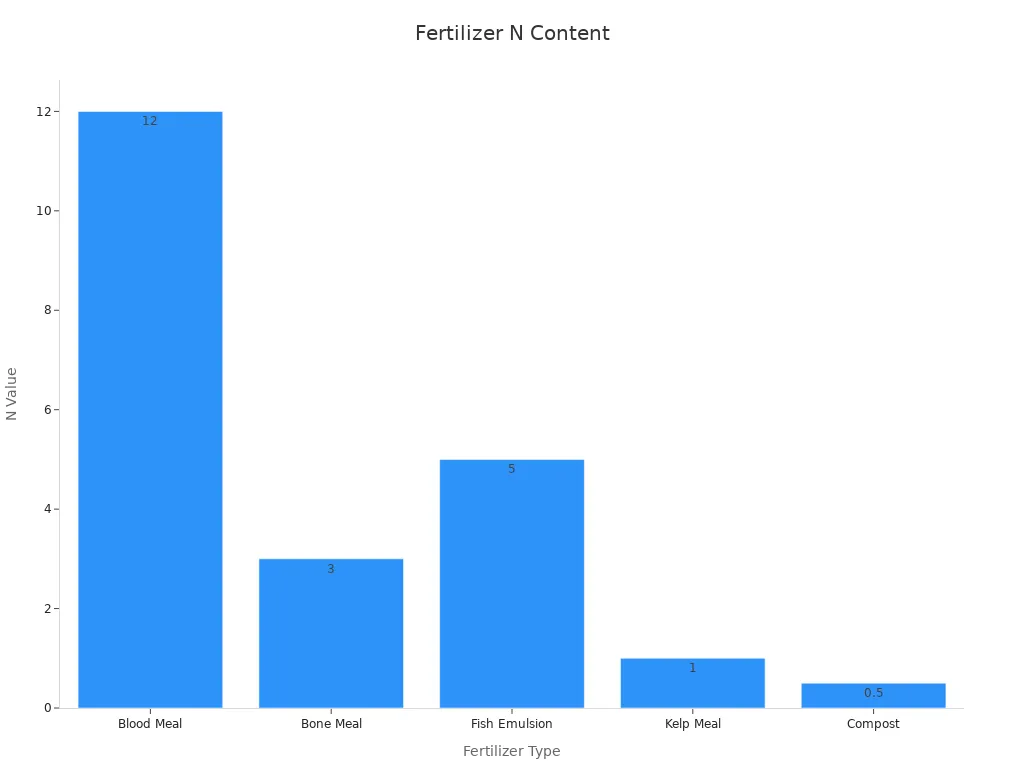
Tip: Always check the N-P-K ratio on the label before applying any organic fertilizer. Adjust the ratio to match the crop’s growth stage and the soil’s nutrient status.
Ingredient Sources
Organic fertilizers for fruit and lawn crops come from a variety of natural sources. Compost, manure, bone meal, fish emulsion, and seaweed extracts each provide unique benefits. For instance, compost improves soil structure and water retention, while bone meal supplies phosphorus for strong roots and flowers. Fish emulsion offers a quick nitrogen boost, and kelp meal delivers micronutrients and stress tolerance.
The table below summarizes common organic fertilizer sources and their best uses:
| Fertilizer Type | NPK Ratio | Best Use Case | Application Timing/Method |
|---|---|---|---|
| Blood Meal | 12-0-0 | Leafy vegetables (e.g., spinach) | Early vegetative growth |
| Bone Meal | 3-15-0 | Root growth and flowering (e.g., tomatoes) | At planting or early growth |
| Fish Emulsion | 5-1-1 | Young seedlings, container gardens | Quick nitrogen boost, foliar spray possible |
| Kelp Meal | 1-0-2 | Micronutrients and stress tolerance | Throughout growth stages |
| Compost | 0.5-0.5-0.5 | Balanced nutrition, soil health | Top-dressing, ongoing soil amendment |
HUMICO Potassium Humate Liquid stands out as a versatile option. This product contains humic acid, fulvic acid, and potassium, making it suitable for a wide range of crops. Its liquid form allows for fertigation and foliar spray, ensuring even distribution and efficient nutrient uptake. Farmers can use it alongside other organic fertilizers for fruit and lawn crops to boost soil health and plant resilience.
Crop Matching
Fruit Trees
Fruit trees, including persimmons and cherries, require a balanced approach to fertilization. These high-value fruits often grow in soils that need regular organic matter additions. Cover crops, mulches, and slow-release rock powders help maintain fertility. Farmers supplement these with organic fertilizers like fish emulsion and kelp for quick nutrient availability. Nitrogen management is critical, especially for young trees. Soil and foliar testing guide how to fertilize, ensuring nutrient balance and preventing deficiencies or toxicities.
Organic fertilizers for fruit and lawn crops must meet organic certification standards. Proper manure incorporation and timing prevent contamination. For cherries, potassium and phosphorus support flowering and fruit set, while humic substances improve root health and stress tolerance. HUMICO Potassium Humate Liquid works well with fruit trees, enhancing nutrient uptake and soil structure through fertigation or foliar spray.
Vegetables
Vegetable crops such as tomatoes, cucumbers, and carrots have distinct nutrient needs. Heavy feeders like tomatoes require nitrogen-rich amendments early in the season, while root vegetables benefit from phosphorus and potassium. Community gardens and commercial farms report higher yields and healthier plants after switching from synthetic fertilizers to compost, worm castings, and fish emulsion. Customized compost blends and liquid fertilizers, adjusted for growth stage, help optimize nutrient uptake.
Soil testing remains essential for vegetables. It identifies deficiencies in nitrogen, phosphorus, potassium, and micronutrients like magnesium and zinc. Farmers use these results to tailor how to fertilize, applying the right organic fertilizer for fruit and lawn crops at the correct rate and time. HUMICO Potassium Humate Liquid supports vegetable growth by improving soil structure and nutrient efficiency, making it a valuable addition to organic management plans.
| Crop | Nitrogen (kg/ha) | Phosphorus (kg/ha) | Potassium (kg/ha) |
|---|---|---|---|
| Tomato | 150-200 | 50-70 | 150-200 |
| Cucumber | 100-150 | 30-50 | 100-150 |
| Carrot | 80-120 | 20-30 | 80-120 |
Lawns
Lawns, especially those planted with Bermuda grass, need steady nutrition for dense, green growth. Organic fertilizers for fruit and lawn crops such as compost, manure, and fish emulsion provide slow-release nutrients that support healthy turf. Homeowners and groundskeepers often use top-dressing and foliar sprays to deliver nutrients efficiently.
Soil testing helps determine the best approach for how to fertilize lawns. It measures pH and nutrient levels, guiding the choice of organic fertilizer and application rate. HUMICO Potassium Humate Liquid enhances soil structure, water retention, and root development in lawns. Its compatibility with other fertilizers and ease of application make it ideal for maintaining high-quality turf.
Note: Regular soil testing, at least once a year, ensures that organic fertilizers for fruit and lawn crops meet the changing needs of the soil and plants. Adjust fertilizer types and rates based on test results, crop stage, and environmental conditions.
How to Fertilize: Practical Steps
- Test the soil before planting or fertilizing.
- Choose an organic fertilizer for fruit and lawn crops that matches the crop’s nutrient needs and soil test results.
- Apply the fertilizer using the recommended method—top-dressing, fertigation, or foliar spray.
- Monitor plant health and adjust applications as needed throughout the season.
Farmers and gardeners who follow these steps see improved yields, healthier plants, and sustainable soil management. Organic fertilizers for fruit and lawn crops, when matched to crop and soil needs, support high market value and long-term productivity.
Application Methods
Applying organic fertilizers and biostimulants correctly ensures that plants receive nutrients when they need them most. Farmers and gardeners who understand how to fertilize at the right time and with the right technique see better results in crop health and yield.
Timing
Growth Stages
Plants have different nutrient needs during each stage of growth. Early growth often requires more nitrogen for leafy development, while flowering and fruiting stages need extra phosphorus and potassium. Applying organic fertilizers to match these stages helps synchronize nutrient release with plant demand. Studies show that split applications—dividing fertilizer into several smaller doses—reduce nutrient loss and improve efficiency. This approach works well because organic fertilizers release nutrients slowly, supporting steady growth and healthy soil.
Seasonal Schedules
Seasonal timing also plays a key role in how to fertilize. For fruit trees, the best time to apply organic fertilizers is in early spring before new growth starts. Vegetables benefit from fertilizer at planting and again during peak growth. Lawns respond well to feeding in early spring and late summer. Long-term experiments confirm that matching fertilizer timing to crop cycles increases soil organic carbon and supports sustained productivity. Farmers who adjust their schedules based on crop and soil needs achieve higher yields and reduce environmental risks.
Techniques
Placement
Proper placement of organic fertilizers ensures that nutrients reach plant roots efficiently. For fruit trees, spreading fertilizer evenly under the canopy and lightly incorporating it into the soil works best. Vegetables benefit from banding fertilizer along rows or mixing it into planting holes. Lawns require even distribution across the surface, followed by watering to move nutrients into the root zone. Mulching after application helps retain moisture and further improves soil structure.
Dosage
Using the correct dosage is essential for effective fertilization. Over-application can waste resources and harm plants, while under-application may not meet crop needs. HUMICO Potassium Humate Liquid offers flexible dosing, with recommended rates ranging from 300 to 600 grams per hectare depending on the crop and growth stage. This product can be applied through fertigation or foliar spray, making it easy to integrate into different farming systems. Always follow label instructions and adjust rates based on soil test results and plant response.
Tip: Regularly monitor plant health and soil conditions to refine how to fertilize throughout the season. Adjust timing, placement, and dosage as needed for fruit trees, vegetables, and lawns.
Monitoring Soil Health
Regular monitoring of soil health forms the foundation for sustainable crop production. Farmers and gardeners who track soil condition and plant health can make informed decisions about fertilization and management. This approach leads to healthy soil, improved yields, and resilient plants.
Soil Testing
pH and Nutrients
Soil testing provides essential information about soil condition and nutrient availability. Accurate sampling methods help determine the true status of nutrients after fertilizer application. Two main approaches exist for collecting samples:
- Whole-field sampling covers the entire area and gives an average reading.
- Precision sampling, such as grid or zone sampling, targets smaller areas and accounts for soil variability.
Sampling depth matters. For nutrients like phosphorus, potassium, and zinc, samples should come from the top 0-6 inches. Deeper samples may be needed for nitrate, depending on the crop. Consistent timing each year, preferably before tillage, ensures reliable results. Proper sample collection and handling have a greater impact on accuracy than laboratory analysis alone. Laboratories may use different philosophies for recommendations, so understanding their approach helps with interpretation. Quality control programs, such as North American Proficiency Testing, support reproducible and accurate results.
Farmers should also credit other nutrient sources, including manure, legumes, and irrigation water, when evaluating soil health. These steps help maintain healthy soil and improve fertilizer efficiency.
| Sampling Method | Area Covered | Best For |
|---|---|---|
| Whole-field | Entire field | Uniform soils |
| Grid/Zone Sampling | Small sections | Variable soils, precision needs |
Plant Signals
Deficiency and Excess
Plants often reveal the state of soil health through visible and invisible signals. Leaves may change color, growth may slow, or roots may appear weak. Recent studies show that plants also produce electrical signals in response to nutrient deficiencies. For example, tomato plants grown in organic substrates displayed unique electrical patterns when lacking iron, manganese, nitrogen, or calcium. These signals appeared before visible symptoms, allowing for early detection of nutrient stress.
Phosphorus and iron deficiencies trigger changes in plant hormones and gene expression. Phosphorus deficiency causes dark-green leaves and anthocyanin buildup, while iron deficiency leads to pale leaves. These physiological changes reflect the soil’s nutrient status and can guide adjustments in fertilization practices. Farmers who observe both visible symptoms and subtle plant signals can respond quickly to maintain soil health.
Tip: Combine regular soil testing with careful observation of plant health. Adjust fertilizer types and rates based on both soil test results and plant signals to support healthy soil and optimal crop growth.
Building Living Soil
Building living soil forms the foundation of resilient and productive agriculture. Healthy soil supports plant growth, improves water retention, and increases resistance to stress. Farmers and gardeners who focus on building organic matter and biodiversity create systems that thrive for generations.
Living Soil Philosophy
Compost and Manure
Compost and manure add organic matter to soil, which boosts fertility and supports a diverse microbial community. Long-term field trials, such as those at the Kellogg Biological Station, show that applying dairy compost each year can increase soil organic matter by 50% over a decade. This rise in organic matter leads to better nutrient holding capacity and improved soil structure. Compost and manure also create habitats for beneficial microbes, which help break down organic materials and release nutrients for plants. Soils treated with compost and manure maintain higher fertility and support healthy crops year after year.
Cover Crops
Cover crops play a key role in building living soil. These plants grow between main crops and add organic matter when they decompose. Cover crops prevent erosion, reduce nutrient loss, and supply nutrients as they break down. Studies show that soils managed with cover crops have higher bacterial diversity and better structure than conventional soils. Cover crops also influence soil pH and nutrient availability, which supports a rich and active microbial community. Farmers who use cover crops see long-term improvements in soil health and productivity.
Sustainable Practices
Reducing Synthetics
Sustainable farming practices focus on reducing synthetic inputs like chemical fertilizers and pesticides. Research from Clemson University highlights that adding organic matter through composting improves soil fertility, lowers input costs, and supports environmental health. Conservation tillage and cover cropping further reduce soil disturbance, which helps retain soil carbon and water. These methods also limit erosion and runoff, making agriculture more resilient and cost-effective.
Environmental Safety
Healthy soil acts as a natural filter, protecting water quality by retaining nutrients and pollutants. Regenerative organic agriculture practices, such as continuous soil cover and minimal disturbance, restore soil organic carbon and biodiversity. These approaches improve soil structure, moisture retention, and resilience to extreme weather. Farms that adopt these methods report better yields, higher soil fertility, and greater profitability. By building living soil, farmers and gardeners contribute to environmental safety and food security.
Products like HUMICO Potassium Humate Liquid help farmers build living soil by increasing organic matter, supporting beneficial microbes, and improving soil structure. This approach allows growers to farm sustainably and protect the environment for future generations.
Biostimulants Boost Cherry Planting
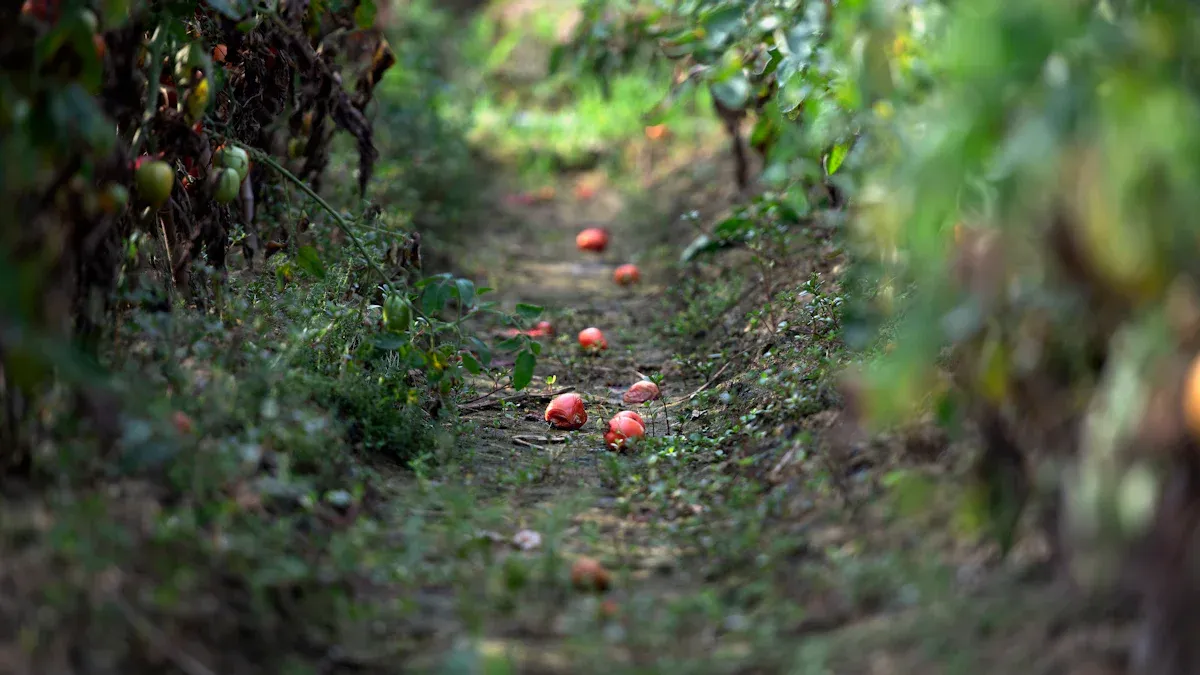
Cherry Crop Benefits
Flowering and Fruit Set
Growers have seen that biostimulants boost cherry planting by improving both flowering and fruit set. Humic acid plays a key role in enhancing tree vigor. It improves soil structure, which allows cherry roots to grow deeper and stronger. This leads to healthier trees that can support more blossoms and fruit. Fulvic acid helps balance plant hormones and accelerates seed germination. It also supports leaf growth and photosynthesis, which are vital for flower and fruit development. When trees face stress, fulvic acid reduces fruit drop, helping maintain stable and high yields.
Amino acid fertilizers support flower bud differentiation during the flowering stage. Later, these fertilizers help cherries swell, resulting in plump, juicy fruit. Seaweed extracts further enhance flower bud formation and fruit setting. They also improve cherry color, sugar content, and shelf life. Protein hydrolysate biostimulants act like natural plant hormones. They contain peptides and free amino acids that signal the plant to grow more flowers and fruit. Studies show that these biostimulants can enhance photosynthesis and support hormone balance, which leads to better yield and fruit quality.
Growers who use biostimulants often report more uniform flowering, improved fruit set, and higher yields in their cherry orchards.
| Biostimulant Type | Main Benefit for Cherries |
|---|---|
| Humic Acid | Enhancing tree vigor, root growth |
| Fulvic Acid | Balancing hormones, reducing fruit drop |
| Amino Acids | Promoting flower bud differentiation |
| Seaweed Extracts | Boosting flower set, improving quality |
Stress Tolerance
Cherries often face stress from drought, heat, or poor soil. Biostimulants help trees cope with these challenges. Controlled experiments on related crops, such as gold cherry tomatoes, show that biostimulants like enzymatic hydrolyzed proteins and seaweed extracts increase plant height, stem diameter, and root length. These treatments also improve yield under low-stress conditions. The highest application rates lead to a 27% increase in yield compared to untreated plants. Researchers believe that bioactive peptides in these products influence plant hormones and metabolism, making trees more resilient.
When cherry trees receive biostimulants, they show better growth and fruit production even in tough environments. Enhanced root systems allow trees to access water and nutrients more efficiently. This resilience supports stable and high yields year after year. By improving stress tolerance, biostimulants help lift the cherry industry sustainably.
Using biostimulants in cherry orchards supports healthy growth, consistent yields, and high-quality fruit, even when conditions are less than ideal.
Sustainable growth begins with selecting organic fertilizers and biostimulants that match crop and soil needs. Farmers apply these products at the right time and rate to support healthy soil. Regular monitoring of soil health and plant signals guides adjustments for better results. Studies show that combining organic fertilizers and biostimulants increases soil organic carbon, improves water use efficiency, and boosts crop yields. These practices reduce chemical fertilizer use and support long-term soil fertility. Healthy soil supports beneficial microbes, enhances nutrient uptake, and leads to a bountiful harvest. Observation, testing, and adaptation help maintain productive soil. For crop-specific advice, growers consult experts or product guides like HUMICO. Soil management remains the foundation of sustainable agriculture, ensuring soil health for future generations.
FAQ
What is the difference between organic fertilizers and biostimulants?
Organic fertilizers supply nutrients directly to plants. Biostimulants help plants use nutrients more efficiently and improve growth. Both support soil health, but biostimulants focus on plant processes and resilience.
How often should farmers apply HUMICO Potassium Humate Liquid?
Farmers usually apply HUMICO Potassium Humate Liquid every 2 to 4 weeks during the growing season. Application frequency depends on crop type, soil condition, and growth stage. Always follow label instructions for best results.
Can HUMICO Potassium Humate Liquid be mixed with other fertilizers?
Yes, HUMICO Potassium Humate Liquid works well with most organic and mineral fertilizers. Mixing improves nutrient uptake and soil structure. Farmers should check compatibility before combining products.
Why is soil testing important before fertilizing?
Soil testing shows nutrient levels and pH. This information helps farmers choose the right fertilizer and application rate. Testing prevents overuse and ensures plants get what they need.
Which crops benefit most from biostimulants?
Fruit trees, vegetables, and lawns all benefit from biostimulants. Cherries, tomatoes, and Bermuda grass show improved growth, yield, and stress tolerance when treated with biostimulants like HUMICO Potassium Humate Liquid.
What is the best way to apply organic fertilizers to lawns?
Apply organic fertilizers evenly across the lawn. Water the area after application to move nutrients into the soil. Top-dressing and foliar sprays both work well for lawns.
Are organic fertilizers safe for the environment?
Organic fertilizers, including HUMICO Potassium Humate Liquid, support sustainable farming. They improve soil health and leave no harmful residues. These products help protect water quality and promote biodiversity.
How can farmers tell if their plants lack nutrients?
Plants show signs like yellow leaves, stunted growth, or poor flowering. Regular observation and soil testing help farmers spot problems early and adjust fertilization practices.

